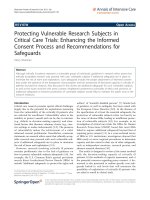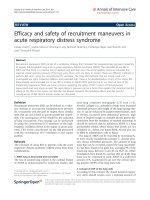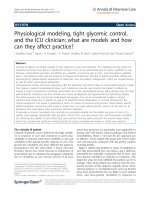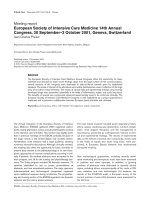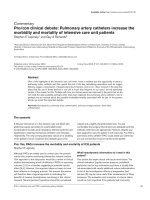PDF Churchills Pocketbook of Intensive Care, 3rd ed PDF Download
Bạn đang xem bản rút gọn của tài liệu. Xem và tải ngay bản đầy đủ của tài liệu tại đây (2.97 MB, 499 trang )
SUBASH KC/NMC-15TH/2014
SUBASH KC/NMC-15TH/2014
COMMON PROBLEMS
The following is a list of problems which commonly cause
difficulty on the ICU. Help can be readily found on the pages
indicated:
Consent
Sedation
Hyperthermia
29
Raised intracranial
pressure 281
34
Enteral feed
Diarrhoea
57
70
Hypotension
87
88
Dysrhythmias
90
Cardiac arrest
109
Oliguria
127
188
Hypernatraemia
Hyperkalaemia
Unexplained sepsis
334
Antibiotic therapy
336
Arterial pressure
monitoring 342
Hypertension
Ventilation
224
Central venous access
Pulmonary artery
catheters 389
Tracheostomy
202
204
Chest drains
404
416
376
SUBASH KC/NMC-15TH/2014
IMPORTANT PRESCRIBING INFORMATION
All doses recommended in this book are, unless stated
otherwise, based on an average (70 kg) adult. Doses
suggested are those typically suitable for critically ill
patients. Individual patients may, however, require more
or less than the doses stated to achieve the optimal
therapeutic, effect depending on particular circumstances.
Many drugs for example may need dose adjustment in
presence of reduced creatinine clearance.
Every effort has been made to ensure the accuracy of the
information contained in this book, particularly that relating
to drugs and drug doses. It is, however, the responsibility
of the prescribing practitioner to ensure that all drug
prescriptions are correct and neither the authors nor the
publishers can be held liable for any errors.
If in doubt seek advice from your pharmacist or consult
the British National Formulary (BNF).
SUBASH KC/NMC-15TH/2014
This page intentionally left blank
SUBASH KC/NMC-15TH/2014
CHURCHILL’S POCKETBOOKS
Intensive Care
SUBASH KC/NMC-15TH/2014
Commissioning Editor: Timothy Horne
Senior Development Editor: Ailsa Laing
Project Manager: Frances Affleck
Designer: Kirsteen Wright
Illustration Manager: Bruce Hogarth
Illustrations: Cactus
SUBASH KC/NMC-15TH/2014
CHURCHILL’S POCKETBOOKS
Intensive
Care
Simon M Whiteley MB BS FRCA MA
Consultant, Intensive Care, St James’s University
Hospital, Leeds, UK
Andrew Bodenham MB BS FRCA
Consultant, Intensive Care, The General Infirmary
at Leeds, Leeds, UK
Mark C Bellamy MA MB BS FRCA
Professor, Intensive Care, St James’s University
Hospital, Leeds, UK
THIRD EDITION
EDINBURGH LONDON NEW YORK OXFORD
PHILADELPHIA ST LOUIS SYDNEY TORONTO 2010
SUBASH KC/NMC-15TH/2014
CHURCHIL LIVINGSTONE
An imprint of Elsevier Limited
First Edition © Pearson Professional Limited 1996
Second Edition © Elsevier Limited 2004
Third edition © 2010, Elsevier Limited. All rights reserved.
No part of this publication may be reproduced or transmitted in any form or by any
means, electronic or mechanical, including photocopying, recording, or any information
storage and retrieval system, without permission in writing from the publisher.
Details on how to seek permission, further information about the Publisher’s
permissions policies and our arrangements with organizations such as the Copyright
Clearance Center and the Copyright Licensing Agency, can be found at our
website: www.elsevier.com/permissions.
This book and the individual contributions contained in it are protected under copyright
by the Publisher (other than as may be noted herein).
ISBN 978-0-443-06977-2
British Library Cataloguing in Publication Data
A catalogue record for this book is available from the British Library
Library of Congress Cataloging in Publication Data
A catalog record for this book is available from the Library of Congress
Notice
Knowledge and best practice in this field are constantly changing. As new research
and experience broaden our understanding, changes in research methods, professional
practices, or medical treatment may become necessary.
Practitioners and researchers must always rely on their own experience and knowledge
in evaluating and using any information, methods, compounds, or experiments
described herein. In using such information or methods they should be mindful of
their own safety and the safety of others, including parties for whom they have a
professional responsibility.
With respect to any drug or pharmaceutical products identified, readers are advised to
check the most current information provided (i) on procedures featured or (ii) by the
manufacturer of each product to be administered, to verify the recommended dose or
formula, the method and duration of administration, and contraindications. It is the
responsibility of practitioners, relying on their own experience and knowledge of their
patients, to make diagnoses, to determine dosages and the best treatment for each
individual patient, and to take all appropriate safety precautions.
To the fullest extent of the law, neither the Publisher nor the authors, contributors, or
editors, assume any liability for any injury and / or damage to persons or property as a
matter of products liability, negligence or otherwise, or from any use or operation of
any methods, products, instructions, or ideas contained in the material herein.
Printed in China
SUBASH KC/NMC-15TH/2014
PREFACE
This small book follows other successful titles in the Churchill’s
Pocketbooks format. It is not intended to compete with the many
already well-established texts in the field of intensive care, but is
intended to present a distillation of sensible practice and ideas.
Every new doctor who is resident in the intensive care unit will
be faced with a large variety of clinical problems to be solved. This
book is therefore based on the common problems the authors are
asked about on a regular basis, most of which can be easily solved
by following simple rules. The aim has been to use the minimum
of space by avoiding excessive detail, and no apology is made
for repetition, or for what may on occasion appear a didactic
approach. Information related to the specialist areas such as
paediatric and cardiothoracic intensive care has been specifically
excluded, although the general principles described are equally
applicable in those areas. In many countries there are increasing
moves to rotate trainees from different specialties, without
previous intensive care experience, through intensive care. The
hope is that this guide will prove timely and useful in this respect.
In the 13 years since the first edition and nine years since the
second was published, there have been a number of changes in
intensive care. We have incorporated these changes into this
new edition. As a result, we have extensively revised the text
and included a number of new or revised figures. The overall
format however, remains the same. We hope that this edition
will continue to provide new trainees in intensive care with safe,
sensible and practical advice.
We are also aware that the book has proved popular with
critical care nurses, physiotherapists and other healthcare
professionals working in critical care, and hope that we have
pitched the detail at the right level to also satisfy this readership
S.M.W.
A.B.
M.C.B.
SUBASH KC/NMC-15TH/2014
This page intentionally left blank
SUBASH KC/NMC-15TH/2014
CONTENTS
1. Organizational issues
Introduction 2
Definitions 2
Levels of care 3
Identification of patients at
risk 4
Critical care outreach 5
Admission policies 6
Prediction of outcome 7
APACHE II severity of illness
score 8
Alternative severity of
illness scoring systems 12
Discharge policies 13
ICU follow-up clinics 15
National audit
databases 15
2. Introduction to
intensive care
Introduction 18
The multidisciplinary
team 18
Daily routine 19
Infection control 19
Assessing a patient 22
Formulating an action
plan 25
Medical records 26
Confidentiality 27
Talking to relatives 28
Consent to treatment in
ICU 29
3. Basic principles
Care bundles 34
Sedation 34
Muscle relaxants 43
Psychological care of
patients 47
Fluids and electrolytes 49
Nutrition 53
Enteral feeding 57
Parenteral nutrition 60
Stress ulcer prophylaxis 62
DVT prophylaxis 63
4. Cardiovascular system
Shock 66
Oxygen delivery and oxygen
consumption 68
Cardiac output 70
Monitoring haemodynamic
status 74
Optimization of
haemodynamic
status 78
Optimization of filling
status 80
Optimization of cardiac
output 82
Optimization of perfusion
pressure 85
Rational use of inotropes
and vasopressors 86
Hypotension 87
Hypertension 88
Disturbances of cardiac
rhythm 90
Conduction defects 98
Myocardial ischaemia 100
Stable angina 100
Acute coronary
syndromes 101
Cardiac failure 105
Cardiogenic shock 106
Pulmonary embolism 107
Pericardial effusion and
cardiac tamponade 108
Cardiac arrest 109
Adult patient with congenital
heart disease 111
5. Respiratory system
Introduction 114
Interpretation of blood
gases 114
SUBASH KC/NMC-15TH/2014
CONTENTS
Definitions of respiratory
failure 116
Management of respiratory
failure 118
Continuous positive airway
pressure (CPAP) 121
Non-invasive positive
pressure ventilation 122
Invasive ventilation 123
Ventilation strategy and
ventilator settings 127
Care of the ventilated
patient 128
Common problems
during artificial
ventilation 131
High frequency modes of
ventilation 133
Weaning from artificial
ventilation 135
Airway obstruction 138
Community-acquired
pneumonia 141
Pandemic influenza 143
Hospital-acquired
pneumonia 143
Pneumonia in
immunocompromised
patients 145
Management of
pneumonia 146
Aspiration
pneumonitis 148
Asthma 149
Chronic obstructive
pulmonary disease 152
Acute lung injury 154
Chest X-ray
interpretation 158
Reduced gastrointestinal
motility 170
Diarrhoea 170
Stress ulceration 172
Gastrointestinal
ischaemia 172
Gastrointestinal
bleeding 172
Intra-abdominal
sepsis 174
Abdominal compartment
syndrome 174
Hepatic dysfunction
during critical
illness 176
Hepatic failure 176
Acute pancreatitis 181
6. Gastrointestinal
system
8. Metabolic and
endocrine problems
Gastrointestinal tract in
critical illness 168
Introduction 202
Sodium 202
7. Renal system
Renal dysfunction in
critical illness 184
Investigation of acute renal
dysfunction 185
Oliguria 188
Management 188
Acute renal failure 189
Renal replacement
therapy 190
Peritoneal dialysis 194
Outcome from acute
renal failure in
intensive care 195
Management of patients
with chronic renal
failure 195
Prescribing in renal
failure 196
Plasma exchange 199
SUBASH KC/NMC-15TH/2014
CONTENTS
Potassium 204
Calcium 207
Phosphate 209
Magnesium 210
Albumin 210
Metabolic acidosis 212
Metabolic alkalosis 215
Disturbances of blood
glucose 215
Diabetic emergencies 217
Adrenal insufficiency 221
Phaeochromocytoma 222
Thyroid dysfunction 223
Temperature control 224
9. Overdose, poisoning
and drug abuse
Overdose and
poisoning 230
Investigations 231
Measures to reduce
absorption/increase
elimination of
drugs 231
Antidotes 233
Intensive care
management 234
Paracetamol 235
Salicylates (aspirin) 236
Benzodiazepines and
opiods 237
Antidepressants 237
Insulin overdose 238
Carbon monoxide and
cyanide poisoning 239
Methanol and ethylene
glycol 240
Alcohol 241
Recreational drug
abuse 242
Problems associated
with intravenous drug
abuse 243
10. Haematological
problems
Introduction 246
Anaemia in the
critically ill 246
Indications for blood
transfusion 246
Blood products in
the UK 247
Administration of blood
products 250
Major haemorrhage 251
Risks and complications of
blood transfusion 252
Patients who refuse
transfusion 254
Normal haemostatic
mechanisms 255
Coagulopathy 258
Thrombocytopenia 262
Disseminated intravascular
coagulation 263
Purpuric disorders 264
Thrombotic disorders 264
The immunocompromised
patient 266
11. Brain injury,
neurological and
neuromuscular
problems
Patterns of brain injury 272
Key concepts in brain
injury 272
Immediate management of
traumatic brain injury 274
Indications for CT scan 279
Indications for
neurosurgical
referral 280
ICU management of
traumatic brain
injury 281
SUBASH KC/NMC-15TH/2014
CONTENTS
Common problems in
traumatic brain injury 284
Monitoring modalities in
brain injury 288
Outcome following brain
injury 290
Stroke and intracranial
haemorrhage 292
Subarachnoid
haemorrhage 292
Hypoxic brain injury 294
Infection 295
Seizures 296
Brainstem death 297
Neuromuscular
conditions 301
Critical illness
neuromyopathy 304
Neurological deficits
following ICU 304
12. Trauma
Introduction 306
Primary survey 306
Exposure and secondary
survey 308
Intensive care
management 309
Head, face and neck
injuries 310
Spinal cord injuries 311
Thoracic injuries 313
Abdominal injuries 316
Skeletal injuries 317
Fat embolism 318
Peripheral compartment
syndromes 319
Rhabdomyolysis 320
Burns 320
Electrocution 322
Near drowning 323
Outcome following
trauma 324
13. Infection and
inflammation
Infection 326
Systemic inflammatory
response syndrome
(SIRS) 326
Definitions 327
Distinguishing
infection 328
Sepsis care bundles 329
Septic shock 331
Investigation of unexplained
sepsis 334
Empirical antibiotic
therapy 336
Source control 336
Problem organisms 336
Catheter-related sepsis 340
Infective endocarditis 341
Necrotizing fasciitis 342
Meningococcal sepsis 342
Notifiable infectious
diseases 345
14. Postoperative and
obstetric patients
Peri-operative
optimization 348
Stress response to surgery
and critical illness 348
Postoperative
analgesia 349
ICU management of
the postoperative
patient 357
Postoperative
haemorrhage 359
Anaphylactoid
reactions 361
Malignant
hyperpyrexia 363
Obstetric patients 364
SUBASH KC/NMC-15TH/2014
CONTENTS
Pre-eclampsia /
eclampsia 365
Peripartum
haemorrhage 366
HELLP syndrome 366
Pregnancy-related heart
failure 367
15. Practical procedures
General information 370
Arterial cannulation 372
Use of pressure
transducers 374
Central venous
cannulation 376
Changing and removing
central venous
catheters 386
Large-bore introducer
sheaths / dialysis
catheters 387
Pulmonary artery
catheterization 389
Measuring PAOP 393
Measurement of
cardiac output by
thermodilution 394
Pericardial aspiration 395
Defibrillation and DC
cardioversion 396
Intubation of the
trachea 398
Extubation of the
trachea 403
Insertion of laryngeal mask
(supraglottic airways) 403
Percutaneous
tracheostomy 404
Cricothyroidotomy /
minitracheostomy 410
Fibreoptic bronchoscopy 412
Bronchoalveolar
lavage 415
Insertion of chest drain 416
Passing a nasogastric
tube 421
Passing a Sengstaken–
Blakemore tube 422
Peritoneal tap / drainage of
ascites 424
Turning a patient
prone 425
Transport of critically ill
patients 426
16. End of life issues
Introduction 430
Treatment limitation
decisions 430
Managing withdrawal of
treatment 431
Confirming death 433
Breaking bad news 434
Issuing a death
certificate 434
Post-mortem
examinations 435
Reporting deaths to the
coroner 436
Brainstem death and organ
donation 437
Non-heart beating organ
donation 439
Cultural aspects of death
and dying 440
Dealing with death at a
personal level 443
Appendices
1. Drug information
2. Drug levels 449
3. Useful links 451
Index 453
445
SUBASH KC/NMC-15TH/2014
ABBREVIATIONS
A&E accident and emergency
ACE angiotensin converting
enzyme
ACN acute cortical necrosis
ACT activated clotting time
ACTH adrenocorticotrophic
hormone
ADH antidiuretic hormone
AF atrial fibrillation
AIDS acquired immune
deficiency syndrome
ALI acute lung injury
APTT activated partial
thromboplastin time
ARDS adult respiratory
distress syndrome
ARF acute renal failure
ASB assisted spontaneous
breathing
AST aspartate
aminotransferase
ATLS Advanced Trauma Life
Support
ATN acute tubular necrosis
AV arteriovenous;
atrioventricular
ANCA antineutrophil
cytoplasmic antibodies
BAL bronchial alveolar
lavage
BIPAP biphasic positive
airways pressure
BNF British National
Formulary
BSA body surface area
CCU coronary care unit
CFM cerebral function
monitor
CK creatinine kinase
CMV controlled mandatory
ventilation; cytomegalovirus
CO cardiac output
COPD chronic obstructive
pulmonary disease
CPAP continuous positive
airway pressure
CPDA citrate, phosphate,
dextrose, adenosine
CPP cerebral perfusion
pressure
CRP C-reactive protein
CSF cerebrospinal fluid
CT computerized tomography
CVA cerebrovascular accident
CVP central venous pressure
CVS cardiovascular system
CVVHD continuous
venovenous haemodialysis
CVVHDF continuous
venovenous
haemodiafiltration
CVVHF continuous
venovenous haemofiltration
CXR chest X-ray
DI diabetes insipidus
DIC disseminated
intravascular coagulation
DKA diabetic ketoacidosis
DVT deep venous thrombosis
EBV Epstein–Barr virus
ECF extra cellular fluid
ECG electrocardiogram
ECMO extracorporeal
membrane oxygenation
EDTA ethylenediamine tetraacetic acid
EPO erythropoietin
ERCP endoscopic retrograde
cholangiopancreatography
ETCO2 end-tidal carbon
dioxide
FBC full blood count
FDP fibrin degradation
product
FFP fresh frozen plasma
FRC functional residual
capacity
GCS Glasgow Coma Scale
SUBASH KC/NMC-15TH/2014
ABBREVIATIONS
GCSF granulocytic-colony
stimulating factor
GFR glomerular filtration
rate
GH growth hormone
GIT gastrointestinal tract
GTN glyceryl trinitrate
HDU high dependency unit
HELLP haemolysis, elevated
liver enzymes, low platelets
HIT heparin-induced
thrombocytopenia
HIV human immunodeficiency
virus
HR heart rate
HUS haemolytic uraemic
syndrome
ICP intracranial pressure
ICNARC Intensive
Care National Audit and
Research Centre
ICU intensive care unit
IHD ischaemic heart disease
INR international normalized
ratio
IPPV intermittent positive
pressure ventilation
ISS injury severity score
LDH lactate dehydrogenase
MAP mean arterial pressure
MH malignant hyperpyrexia
MODS multiorgan
dysfunction syndrome
MRSA methicillin-resistant
Staphylococcus Aureus
NG nasogastric
NIPPV non-invasive
ventilation
NSAID non-steroidal antiinflammatory drug
PA pulmonary artery
PACS picture archiving
computer systems (digital
X-rays)
PACU post-anaesthesia care
unit
PAF platelet activating factor
PAFC pulmonary artery
flotation catheter
PAOP pulmonary artery
occlusion pressure
PCA patient-controlled
analgesia
PCP Pneumocystis carinii
pneumonia
PCR polymerase chain
reaction
PE pulmonary embolism
PEA pulseless electrical
activity
PEEP positive end expiratory
pressure
PEG percutaneous endoscopic
gastrostomy
PT prothrombin time
RAST radioallergosorbent
tests
RRT renal replacement
therapy
RTS revised trauma score
RV right ventricle
SAGM sodium chloride,
adenosine, glucose, mannitol
SAPS Simplified Acute
Physiology Score
SARS severe adult respiratory
syndrome
SCID severe combined
immune deficiency
SDD selective
decontamination digestive
tract
SIADH syndrome of
inappropriate antidiuretic
hormone
SIMV synchronized
intermittent mandatory
ventilation
SUBASH KC/NMC-15TH/2014
ABBREVIATIONS
SIRS systemic inflammatory
response syndrome
SV stroke volume
SVR systemic vascular
resistance
SVT supraventricular
tachycardia
T3 tri-iodothyronine
T4 thyroxine
TEG thromboelastogram
TIA transient ischaemic attack
TIPSS transvenous
intrahepatic portosystemic
shunt
TISS Therapeutic Intervention
Scoring System
TNF tumour necrosis factor
TO4 train of four
TPA tissue plasminogen
activator
TPN total parenteral
nutrition
TRALI transfusion-related
acute lung injury
TSH thyroid stimulating
hormone
TT thrombin time
TTP thrombotic
thrombocytopenic purpura
U&E urea and electrolytes
VCJD variant Creutzfeldt–
Jakob disease
VF ventricular fibrillation
VPB ventricular premature
beat
VRE vancomycin-resistant
enterococci
VSD ventricular septal
defect
WCC white cell count
SUBASH KC/NMC-15TH/2014
CHAPTER 1
ORGANIZATIONAL
ISSUES
Introduction 2
Definitions 2
Levels of care 3
Identification of
patients at risk 4
Critical care outreach 5
Admission policies 6
Prediction of outcome 7
APACHE II severity of
illness score 8
Alternative severity of
illness scoring systems 12
Discharge policies 13
ICU follow-up clinics 15
National audit
databases 15
SUBASH KC/NMC-15TH/2014
2
O R G A N I Z AT I O N A L I S S U E S
᭤ DEFINITIONS
INTRODUCTION
Modern intensive care originated during the poliomyelitis
epidemics of the 1950s, when tracheal intubation and positive
pressure ventilation were applied to polio victims, resulting in a
substantial improvement in survival. Patients were managed in
a specific part of the hospital and received one-to-one nursing
care, features that still largely define intensive care units (ICUs)
to this day. From these beginnings, there was a gradual
development until the ICU was a recognizable component of
most general hospitals.
In the early days of intensive care, patients were often
young and previously fit, with only single organ failure. If they
survived, a full functional recovery could be anticipated. Today,
in keeping with the changing structure of society, patients are
often elderly and many have complex pre-existing medical
problems, which predispose them to develop multiple organ
failure during critical illness. As a consequence, the prospects
for survival from critical illness are sometimes limited. This,
together with the realization of the large costs involved in
providing intensive care, typically approaching £2000 per day,
has led to debate about how intensive care should be provided
in the future. In particular, there is increasing focus on the
complex ethical issues that surround admission, provision and
discontinuation of intensive care therapy.
Nevertheless, intensive care medicine has become an
established and fundamental part of modern health care.
Critical illness may arise from a variety of disease processes,
but the pathophysiological changes that result lead to common
patterns of organ dysfunction. By recognizing these patterns and
understanding the interactions between different organ systems,
intensive care teams can improve the outcome of critically ill
patients. The role of intensive care includes:
Resuscitation and stabilization
Physiological optimization of patients to prevent organ failure
Facilitation of complex surgery
Support of failing organ systems
Recognition of futility.
DEFINITIONS
Traditional definitions of ICUs and high dependency units
(HDUs) attempt to separate the functions of each.
SUBASH KC/NMC-15TH/2014
O R G A N I Z AT I O N A L I S S U E S
LEVELS OF CARE ᭣
Intensive care unit (ICU)
An area for patients admitted for the treatment of actual or
impending organ failure, especially those requiring assisted
ventilation. There is usually at least one nurse per patient and a
doctor assigned solely to the intensive care unit throughout the
24-h period.
High dependency unit (HDU)
An area for patients who require more intensive observation or
intervention than can be provided on a general ward, but who
do not require assisted ventilation. Nurse-to-patient ratios are
generally between those of an ICU and a general ward. There is
not usually dedicated medical cover.
There are, however, difficulties with such definitions. In many
smaller hospitals for example, the ICU, HDU and coronary
care unit (CCU) are often combined in one area, with nursing
and medical staff working flexibly as required. Post-anaesthesia
care units (PACUs) or recovery rooms may be used to ventilate
patients when the ICU is full. Many patients with chronic
respiratory disease are now ventilated on respiratory wards, either
via face / nasal masks or by long-term tracheostomy.
It is increasingly recognized, therefore, that the level of medical
and nursing care received by individual patients should not be a
function of their physical location, in an ICU or on the ward, but a
function of their clinical condition. This has led to the classification
of levels of care for critically ill patients based solely on need.
LEVELS OF CARE
Critically ill patients can be classified according to the level of
medical and nursing care required (see Intensive Care Society 2002
Levels of Critical Care for Adult Patients www.ics.ac.uk/icmprof/
downloads/icsstandards-levelsofca.pdf) (Table 1.1).
Patients should be nursed in an area capable of providing the
appropriate level of care. While level 2 care may be provided
in an HDU or ICU, true level 3 care can only be provided in
a suitably equipped ICU. In reality, these levels of care are
not discrete entities, but represent points on a continuum or
spectrum. As their condition changes, patients may need a
greater or lesser level of care, and frequently move between the
defined levels.
3
SUBASH KC/NMC-15TH/2014
4
O R G A N I Z AT I O N A L I S S U E S
᭤ I D E N T I F I C AT I O N O F PAT I E N T S AT R I S K
TABLE 1.1 Levels of critical care
Level 0
Patients whose needs can be met by ward-based care in an
acute hospital.
Level 1
Patients at risk of their condition deteriorating (including
those recently moved from higher levels of care) whose
needs can be met on a normal ward with additional
advice or support from the critical care team.
Level 2
Patients requiring more advanced levels of observation
or intervention than can be provided on a normal ward,
including support for a single failing organ system.
Level 3
Patients requiring advanced respiratory support alone or
basic respiratory support together with support for at
least two organ systems.
Specialist care is recorded by attaching one of the following letters as
a suffix.
N – neurosurgical, C – cardiac, T – thoracic, B – burns, S – spinal injury,
R – renal, L – liver, A – other specialist care.
TABLE 1.2 Typical early warning scoring system
Score
Heart rate
BP
3
2
Ͻ40
41–50
0
1
Ͻ8
Temp.
Ͻ35
2
3
51–100 101–110 111–130 Ͼ130
Ͻ70 71–80 81–100 101–199
RR
CNS
1
Ͼ200
9–14
15–20
A
V
21–29
Ͼ30
Ͼ38.5
35.1–36.5
P
U
A: alert; V: responds to voice; P: responds to pain; U: unresponsive
IDENTIFICATION OF PATIENTS AT RISK
As the level of care required by an individual patient can change
rapidly, it is important that those at risk of deterioration and
needing increased levels of care are identified early, so that the
appropriate interventions can be instituted.
A number of scoring systems have been developed to help staff
detect those patients who are at risk. These are based on the principle
that patients develop abnormal physiological parameters as their
condition starts to deteriorate. The scoring system can be used by any
member of the ward medical or nursing staff and if appropriate, the
intensive care outreach team can be called (see below). An example
of a typical early warning scoring system is shown in Table 1.2. The
response triggered by the scoring system is shown in Table 1.3.
SUBASH KC/NMC-15TH/2014
O R G A N I Z AT I O N A L I S S U E S
CRITICAL CARE OUTREACH ᭣
TABLE 1.3 Typical response to early warning scoring system
Ward area
Score Ͼ 3
Call outreach team
High dependency area
Score Ͼ 3
Call responsible medical staff
Score Ͼ 5
Call outreach team / ICU
Score Ͼ 10
Call outreach Team / ICU
Any area
CRITICAL CARE OUTREACH
Outreach is a relatively new concept in critical care. Traditionally,
intensive care staff have tended to stay in the ICU and await the
referral of patients from other areas by the attending medical staff.
It is increasingly recognized, however, that the ICU staff have
much to offer critically ill and potentially critically ill patients
outside the ICU. This has led to the development of critical care
outreach teams.
These teams commonly consist of senior members of medical,
nursing and physiotherapy staff from the ICU who provide a
liaison service and an immediate point of contact between the ICU
and other areas of the hospital. Their roles include:
Identification of patients at risk
Prevention of further deterioration and the need for
subsequent ICU admission
Support for level 1 care on the wards
Education and the promotion of critical care skills
Identification of patients unlikely to benefit from ICU
admission
Facilitation of discharges from higher levels of care back to
the ward.
Once contacted, the outreach team will usually assess a patient
and may offer advice and support to ward staff. Early advice on
matters such as fluid management and provision of intermediate
respiratory support (e.g. physiotherapy / high flow oxygen / CPAP)
may prevent further deterioration and enable the care of the
patient to continue at ward level (level 1 care). Alternatively, the
team may institute more advanced therapy and expedite transfer
to an area capable of providing a higher level of care (level 2 or 3).
Occasionally the outreach team may, in consultation with
the patient, relatives, and the parent medical team, decide that
a patient is unlikely to benefit from intensive care and that
admission would not be appropriate (see Limitation of treatment,
p. 430).
5
SUBASH KC/NMC-15TH/2014
6
O R G A N I Z AT I O N A L I S S U E S
᭤ ADMISSION POLICIES
ADMISSION POLICIES
The aim of intensive care is to support patients while they
recover. It is not to prolong life when there is no hope of recovery.
Sometimes difficult decisions have to be made about whether or
not to admit a patient to intensive care, as there is often a shortage
of intensive care beds and a requirement to use the available
resources responsibly and equitably. To aid decision making, some
units have written admission policies. A typical admission policy is
shown in Box 1.1.
The difficulty with all admission policies, however, is that it is
impossible to predict with complete accuracy which individual
patients stand to benefit from admission to intensive care.
Box 1.1 Admission policy
Requests for admission
●
Patients will be admitted to ICU who in the opinion of the ICU
consultant are likely to benefit from a period of intensive care.
Patients in whom further treatment is considered futile will not
normally be admitted.
●
Requests for admission should be made by contacting the ICU
consultant on call. Requests should normally come from a consultant
who has seen the patient immediately prior to making a referral.
●
In the case of elective surgery where the admission of the patient
can be foreseen a request should be made at least 24 hours prior
to surgery. The bed should be confirmed immediately prior to
commencement of anaesthesia.
Bed management issues
●
All problems related to availability of beds will be dealt with initially
by the ICU consultant on call, who is in a position to make decisions
about the potential admission and the needs of the patients already
in the ICU.
●
If there are no beds immediately available, the continued provision of
care at an appropriate level to the patient remains the responsibility
of the staff in attendance, supported where possible by the ICU
outreach team.
●
Where no ICU bed is available, the ICU consultant may be able to
give advice as to the location of other available ICU beds; however,
their prime responsibility is to patients already in the ICU.
Joint responsibility
●
All patients will be admitted under the care of a named ICU
consultant and the ICU team will assume responsibility for the
patients care. (Responsibility may be shared jointly with the admitting
team.)
Discharges
●
Will be arranged by the ICU staff in conjunction with the responsible
consultant. In cases of emergency, however, patients may be
discharged by the consultant on-call for the ICU.
SUBASH KC/NMC-15TH/2014
O R G A N I Z AT I O N A L I S S U E S
PREDICTION OF OUTCOME ᭣
In practice, therefore, the decision whether or not to admit a
patient to intensive care is usually based on the outcome of
multidisciplinary discussion and clinical expertise.
Instantaneous judgements regarding the continuation or
withdrawal of treatment from patients in the operating theatre,
resuscitation room or on the wards are often difficult and
increasingly, lawyers, patient advocates, independent mental
capacity advocates (IMCAs) and clinical ethicists are being
involved in the most difficult decisions. Senior staff should be
involved early on. In many cases, unless the outlook is truly
hopeless, patients will be admitted for a trial of treatment to see
whether they will stabilize and improve over time.
Additionally, patients with little or no prospect of survival
may occasionally be admitted to intensive care. For example,
patients from the resuscitation room, or those who have suffered
catastrophic complications during surgery, may be admitted even
though they are likely to die. This is to facilitate more appropriate
terminal care, or to allow the relatives time to visit and the
bereavement process to be better managed. This is a justifiable and
appropriate use of a critical care facility. Admission policies need,
therefore, to be sufficiently flexible to allow the admission of what
may seem, on occasion, like inappropriate cases (see Treatment
limitation decisions, p. 430).
PREDICTION OF OUTCOME
The difficulties outlined above have led to a wealth of work,
using scoring systems, to predict the outcome of patients treated
in intensive care. This generally involves the collection of a large
amount of data from many patients, stratification of the data
to produce a risk score, prospective validation of the score, and
its subsequent application to clinical decision making in specific
cases. There are, however, major difficulties with this approach:
●
There is, as yet, no satisfactory diagnostic categorization for
intensive care patients. Often the problems relating to intensive
care admission bear little relation to the original presenting
complaint or diagnostic category.
Although patients may survive to leave the ICU, there is a
significant mortality on the wards, and later at home, after
leaving intensive care. Many studies use 28-day mortality as
an end point. It has been suggested that 6-month or 1-year
outcomes of mortality and measures of morbidity (quality of
life measures) are better end points.
7

